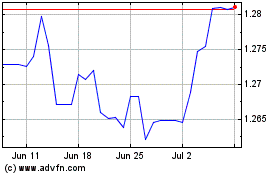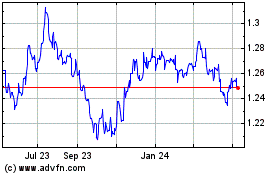Euro Falls As European Shares Decline On Rising Trade War Worries
July 11 2018 - 3:03AM
RTTF2
The euro declined against its major counterparts in the European
session on Wednesday amid risk aversion, as investors fretted about
an escalating trade war between the world's two largest
economies.
Beijing vowed to take countermeasures after the U.S. proposed
tariffs on an extra $200 billion of Chinese goods.
The move comes after the U.S. imposed 25 percent tariffs on $34
billion of Chinese imports on Friday, for which Beijing immediately
retaliated in equal measure.
German bond yields also declined, with the yield on 10-year note
down by 0.30 percent. Yields move inversely to bond prices.
The currency traded mixed against its major counterparts in the
Asian session. While it held steady against the greenback and the
pound, it fell against the yen and the franc.
The euro slipped to 1.1695 against the greenback, from a high of
1.1746 hit at 5:10 pm ET. If the euro continues its fall, 1.15 is
possibly seen as its next support level.
The 19-nation currency weakened to a 2-day low of 1.1619 against
the franc, after having advanced to 1.1653 at 5:10 pm ET. The euro
is seen finding support around the 1.14 level.
The European currency dropped to 0.8830 against the pound,
reversing from a high of 0.8852 hit at 6:30 pm ET. The next likely
support for the euro is seen around the 0.87 area.
The euro retreated to 1.5394 against the loonie, coming from a
5-day high of 1.5430 hit at 9:05 pm ET. On the downside, 1.52 is
possibly seen as the next support level for the euro.
The euro held steady against the yen, after having fallen to a
2-day low of 129.91 at 9:00 pm ET. At Tuesday's close, the pair was
worth 130.34.
Data from the Ministry of Economy, Trade and Industry showed
that Japan's tertiary activity index increased for the second
straight month in May.
The tertiary activity index edged up 0.1 percent
month-over-month in May, following a 1.0 percent rise in April. In
contrast, economists had expected a 0.3 percent decrease for the
month.
On the flip side, the euro advanced to 6-day highs of 1.7255
against the kiwi and 1.5854 against the aussie, from its early lows
of 1.7164 and 1.5735, respectively. The next possible resistance
for the euro is seen around 1.74 against the kiwi and 1.60 against
the aussie.
Looking ahead, U.S. PPI for June and wholesale inventories for
May are due in the New York session.
The Bank of Canada is scheduled to release its interest rate
decision at 10:00 am ET. Economists forecast the benchmark rate to
be raised to 1.50 percent from 1.25 percent.
Sterling vs US Dollar (FX:GBPUSD)
Forex Chart
From Mar 2024 to Apr 2024

Sterling vs US Dollar (FX:GBPUSD)
Forex Chart
From Apr 2023 to Apr 2024
